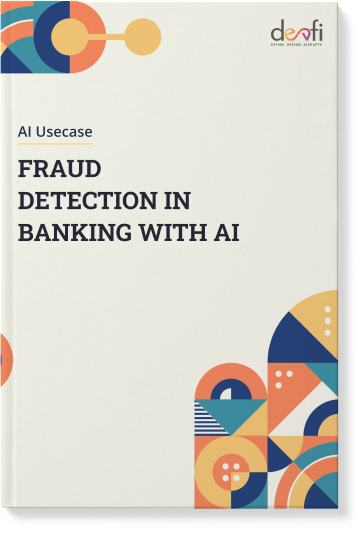AI is becoming more prevalent in organizations as they seek to improve their operations and automate their processes. According to Gartner, the number of organizations using cloud-based AI is expected to grow 5 times by 2023. And the banking sector is one of the few frontrunners in adopting AI and reaping significant benefits like automating processes, increased productivity, personalized customer service, precise risk analysis, predictive analytics, advanced fraud detection and prevention, and many more.
Challenges
However, with more data generated, there is a significant threat to the banking industry in detecting and preventing fraud before they happen - be it credit/debit card fraud, employment or tax-related fraud, document fraud, mortgage fraud, identity theft, or email phishing. Machine learning can help organizations minimize their exposure to fraud. With Deep learning, they can create automated processes that can help prevent their customers from being victims of fraud. But, the path to AI-powered fraud detection isn’t simple and straight.
- Changing fraud patterns – One of the biggest challenges that Machine learning models face in detecting and preventing fraud is the changing fraud patterns that fraudsters adopt to get into the systems. It is important that the deep learning models are updated regularly with the new fraud patterns detected. This might, at times, result in a decrease in model performance and efficiency.
- Cold start – Another issue that businesses face when it comes to adopting Machine learning models is the need for a large amount of data to be collected and processed. This can be very challenging for small and medium-sized businesses. Without the necessary data, the machines may make erroneous and irrelevant fraud assessments.
- Feature generation – Due to the complexity of the task, it can take experts a long time to develop a comprehensive feature set that will allow them to perform effective fraud detection.
- Lack of explainability on model interpretations – AI models typically provide a score that indicates if the transaction is likely to be fraudulent or not. There exists a lack of explainability on why they are or are not fraudulent.
- Model risk management – The tension between the need for speed and the necessity of proper processes in model risk validation can be a real challenge when it comes to AI initiatives. After all, mitigating risk is the top priority – which means that any shortcuts that might compromise the quality of the validation itself are not an option.
Solutions
Fraud detection with machine learning is more effective and efficient than the traditional ways. Machine learning algorithms can identify patterns that often go unnoticed. These algorithms study thousands of cases of fraud to find the most effective and hidden patterns, analyze these patterns, and remember them forever.
Ensemble modeling – An ensemble model is a process used to predict an outcome from multiple models. It can be done by using various models and techniques, or by using various training data sets. After aggregating all the predictions, the model comes up with a final prediction that is based on the unseen data. With multiple models for a single task of tackling the evolving fraudulent patterns, ensemble modeling can tackle the increasing complexity of fraud detection. Through deep learning, machine learning, and linear models, it can capture various patterns to maximize its output.
Human intervention – By bringing humans into the loop, we can improve the efficiency of feature detection by providing models with more accurate information about fraud. Through this process, humans can help models identify new features and patterns of fraud. Through human input, a model learns from its examples and identifies more from its learning.
Explainable AI – AI that is designed to explain decisions is known as an explainable AI, which makes them visible to users. Developers can then use these codes to make the decisions more understandable. For instance, if an account manager suspects that a certain decision might have an unfair advantage, they can modify the model to remove that inequity. The concept of explainable AI can help solve the model interpretation challenge for financial transactions. A few explainability techniques like surrogate modeling can provide useful insight into the approval or decline of a transaction due to fraud.
Validating the model risk – Addressing the challenge of validating model risk can be done by introducing consistency and reproducibility into the process of validations and the final pushes to production. This way, banks are able to quickly move through the validation stage and have everyone across the company working with the same tool. Once models need to be validated, the team evaluating their risk knows what they’re dealing with and how to find the data sources on which the model is built. Having the models and validation completed in the same tool helps ensure that the deployment to production is as smooth as possible.
Machine learning is a promising tool for businesses to detect and prevent fraud as it can help them identify and stop fraudulent activities before they happen. Besides implementing fraud detection solutions, Devfi provides secure and modern FinTech solutions and services to prevent fraud and keep its operations running smoothly. For more details, contact us.






